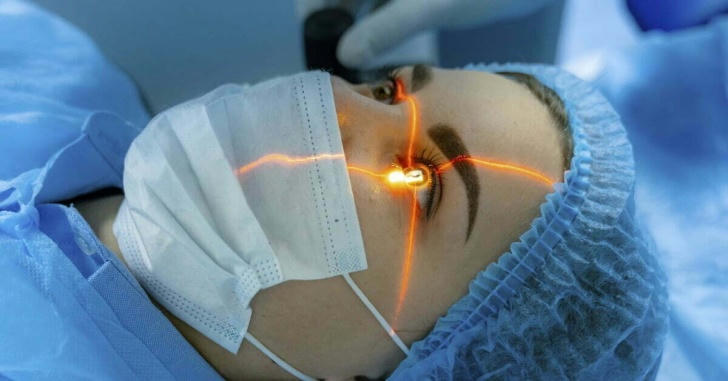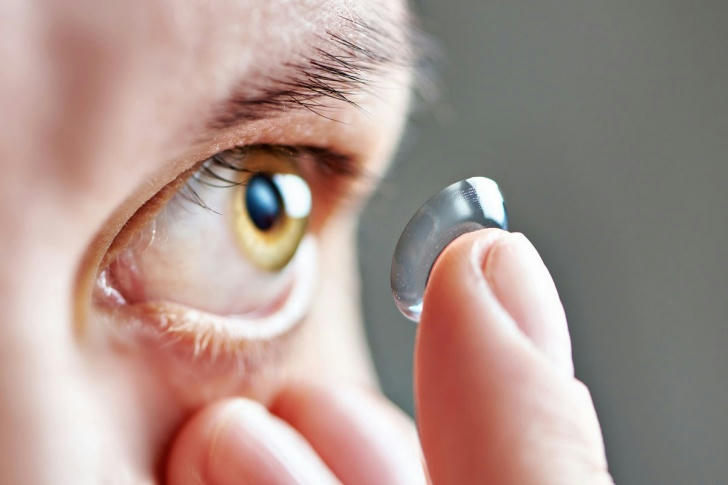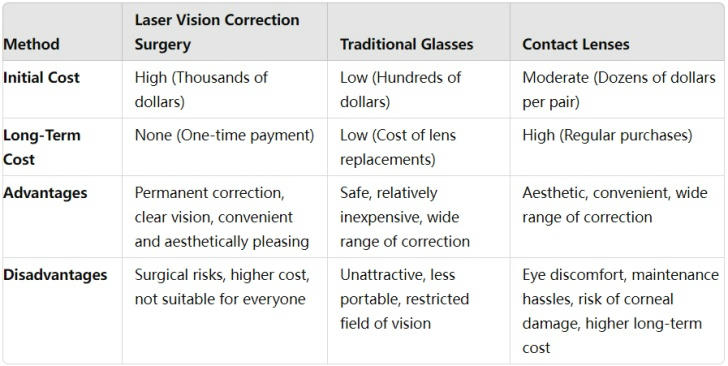Laser Eye Surgery vs. Traditional Glasses and Contact Lenses: Which Choice is Right for You?
Nearsightedness has become a common vision problem in modern life. It not only affects our daily activities but also reduces our quality of life. For those who want to improve their vision, choosing the right corrective method is crucial. This article will compare the pros and cons of laser eye surgery, traditional glasses, and contact lenses to help you make the best choice for yourself.

Laser Vision Correction Surgery
1.1 What is Laser Vision Correction Surgery?
Laser vision correction surgery is a procedure that uses laser technology to improve vision. The main types include:
• LASIK (Laser•Assisted In Situ Keratomileusis): This procedure reshapes the cornea using a laser so that light can be accurately focused on the retina.
• PRK (Photorefractive Keratectomy): This involves directly applying a laser to the surface of the cornea, making it suitable for patients with thinner corneas.
• SMILE (Small Incision Lenticule Extraction): This technique removes a small piece of tissue from within the cornea through a tiny incision, adjusting the vision.
1.2 Advantages of Laser Vision Correction Surgery
• Long•Lasting Results with No Daily Maintenance: After one procedure, vision is usually significantly improved for the long term, with no need for daily maintenance like glasses or contact lenses.
• Quick Improvement in Vision: Vision typically improves significantly within a few days after the surgery.
• Freedom from Glasses or Contact Lenses: Many patients can eliminate the need for glasses and contact lenses, enjoying a more liberated lifestyle.
1.3 Disadvantages of Laser Vision Correction Surgery
• Higher Cost: The cost of the surgery is generally higher compared to glasses and contact lenses.
• Risks and Possible Side Effects: Although most surgeries are successful, there are risks such as unstable vision or dry eyes.
• Post•Surgery Recovery and Care Requirements: There is a recovery period after the surgery that may involve discomfort and requires following specific care instructions.
1.4 Suitable Candidates
• Stable Vision in the Short Term: It is generally recommended for individuals over 18 with stable vision over a period.
• No Severe Eye Diseases or Other Contraindications: The thickness of the cornea is a crucial factor affecting the success of the surgery. Candidates should not have conditions such as glaucoma, cataracts, or corneal infections, and should not have systemic diseases like diabetes or hypertension.

Traditional Glasses
2.1 What Are Traditional Glasses?
Traditional glasses correct vision through the refractive power of lenses. They consist of a frame and lenses. The lenses alter the path of light so that it correctly focuses on the retina.
2.2 Advantages of Traditional Glasses
• Lower Cost: The initial cost of purchasing glasses is relatively low compared to the expense of surgery.
• No Surgical Risks: Glasses do not involve surgery, thus avoiding the risks and side effects associated with surgical procedures.
• Ease of Lens Replacement: Lenses can be easily replaced to accommodate changes in vision, allowing for convenient adjustments.
2.3 Disadvantages of Traditional Glasses
• Dependence on Glasses, Potential Impact on Appearance and Activities: Long•term use of glasses may affect appearance and can be inconvenient during physical activities.
• Not Suitable for Certain Sports or Work Environments: Glasses may not be practical for high•intensity sports or specific work environments where safety and functionality are critical.
• Requires Regular Cleaning and Maintenance: Lenses need to be cleaned regularly, and maintenance can be somewhat cumbersome.
2.4 Suitable Candidates
• Individuals with Fluctuating or Unstable Vision: Glasses are suitable for those with changing vision, especially for younger people whose vision is still developing. For such individuals, wearing glasses is often the best option.
• Budget•Conscious Individuals: Glasses are a more economical choice for those with a limited budget.

Contact Lenses
3.1 What Are Contact Lenses?
Contact lenses are thin discs worn directly on the eye, designed to correct vision by covering the cornea. Common types include:
• Daily Disposable Contact Lenses: These are replaced every day, offering convenience and hygiene but are relatively more expensive than other types.
• Monthly Disposable Contact Lenses: These are replaced once a month and are more economical, though they require daily cleaning and disinfection.
• Rigid Gas Permeable Lenses: These are more durable and have better oxygen permeability, suitable for extended wear, but are relatively higher in cost.
3.2 Advantages of Contact Lenses
• Does Not Affect Appearance and Does Not Interfere with Daily Activities: Contact lenses are less noticeable compared to glasses, making them ideal for individuals concerned about their appearance.
• Suitable for Athletes and Professionals Requiring High•Definition Vision: Contact lenses do not shift during physical activities, making them suitable for athletes and those who need clear vision for their work.
• Addresses Discomfort Associated with Glasses: For those who find glasses uncomfortable, contact lenses offer a good alternative.
3.3 Disadvantages of Contact Lenses
• Requires Daily Cleaning and Maintenance: Contact lenses need regular replacement, and daily cleaning and care are necessary to prevent eye infections.
• Potential for Eye Infections or Discomfort: As contact lenses sit directly on the cornea, they can lead to dryness, foreign body sensation, itching, or redness if not properly managed.
• Long•Term Costs and Risks: The long•term cost of contact lenses can add up. Prolonged wear, sleeping with lenses, and poor eye hygiene can lead to corneal damage.
3.4 Suitable Candidates
• Those Concerned About Appearance or in Careers Requiring Clear Vision: Ideal for individuals who prefer a more discreet option or need high•definition vision for their professional activities.
• Those Who Can Manage Long•Term Costs and Maintenance: Suitable for individuals willing to invest time and money in the ongoing care and costs associated with contact lenses.

Comparative Overview
Case 1: Emma, the Busy Professional
Background: Emma, a 32•year•old marketing manager, has a hectic schedule with frequent business meetings and travel. She has been using glasses for years but finds them cumbersome during presentations and video calls.
Options:
• Laser Vision Correction: Emma decides to explore LASIK surgery. The procedure offers a permanent solution and allows her to be free from glasses, which aligns with her busy lifestyle. Post•surgery, she experiences significant improvement in vision within days and enjoys the convenience of not needing to worry about glasses during her work.
• Traditional Glasses: Emma finds glasses inconvenient for her active professional life, as they often get in the way during meetings and travel. While glasses are cost•effective and safe, they do not address her need for a more practical, hands•free solution.
• Contact Lenses: She considers contact lenses, which provide unobstructed vision and are suitable for her active work. However, she is concerned about the daily maintenance and potential discomfort from extended wear.
Outcome: Emma opts for LASIK surgery due to its long•term benefits and convenience, perfectly fitting her dynamic work environment.
Case 2: Jack, the College Student
Background: Jack, a 21•year•old college student, is in the midst of his studies and part•time job. His vision is still changing as he is growing, and he needs a solution that is affordable and flexible.
Options:
• Laser Vision Correction: Jack considers laser surgery but is hesitant due to the high cost and the fact that his vision may still be changing. He also has concerns about surgery risks and recovery time.
• Traditional Glasses: Jack finds glasses to be a suitable and budget•friendly option. They are easy to adjust and replace if his prescription changes. Glasses also allow him to see clearly without the need for surgery.
• Contact Lenses: Jack is intrigued by contact lenses as they offer a more flexible and visually appealing alternative to glasses. However, he is concerned about the cost of ongoing replacements and the need for diligent eye care.
Outcome: Jack chooses traditional glasses due to their affordability and adaptability to his changing vision. They provide a reliable solution while fitting his student budget.
Case 3: Sarah, the Active Retiree
Background: Sarah, a 65•year•old retiree, enjoys hiking, gardening, and traveling. Her vision has stabilized, and she is looking for a solution that enhances her quality of life without frequent maintenance.
Options:
• Laser Vision Correction: Sarah explores SMILE surgery. Given her stable vision and interest in an active lifestyle, she sees the potential for permanent vision improvement and freedom from glasses and contacts.
• Traditional Glasses: Sarah finds glasses to be effective but cumbersome during physical activities. They also require regular cleaning and can be an inconvenience while traveling.
• Contact Lenses: While contact lenses offer unobstructed vision and flexibility, Sarah is concerned about the daily care required and the risk of potential infections.
Outcome: Sarah opts for laser vision correction, appreciating the long•term benefits and freedom from both glasses and contact lenses, which enhances her active retirement lifestyle.
Conclusion
Choosing the right vision correction method involves considering multiple factors, including budget, lifestyle, and vision stability. Laser vision correction surgery is suitable for those who wish to eliminate glasses and contact lenses. Traditional glasses are ideal for those with limited budgets or unstable vision. Contact lenses are best for individuals who need unobstructed vision and can adhere to maintenance routines.
Call to Action
If you are considering a vision correction method, it is recommended to consult with a professional ophthalmologist for personalized advice
